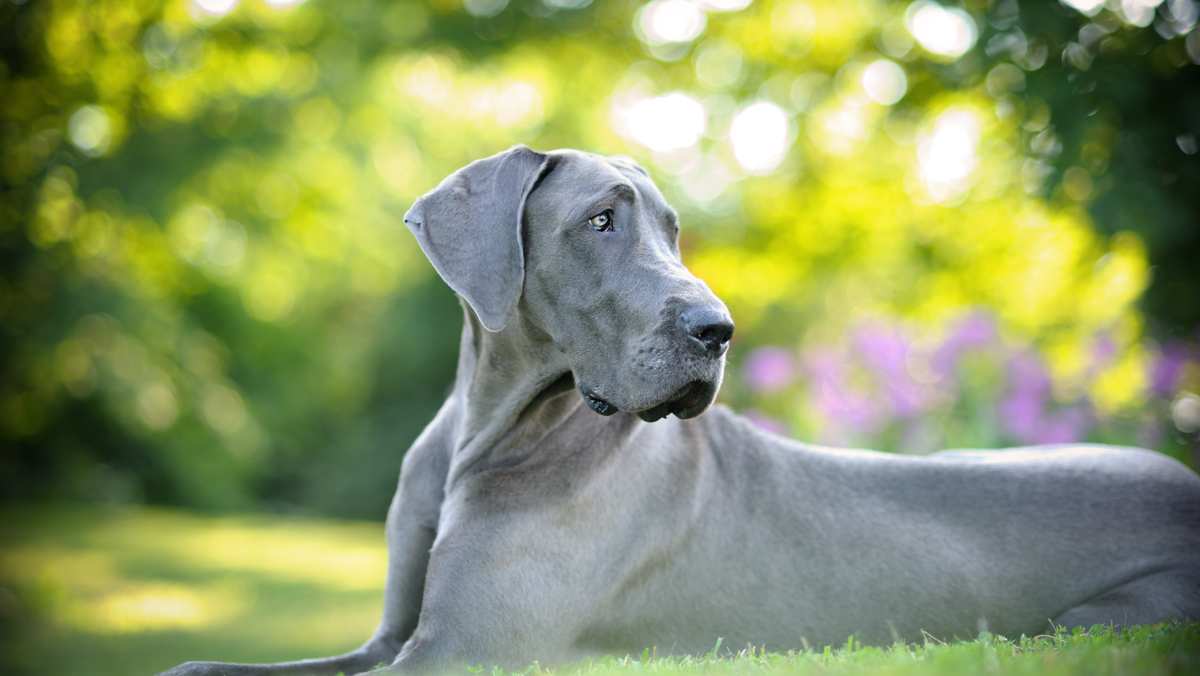Great Dane Breed Details
Below are the characteristics and traits of the great dane dog breed.

Commonly called the "Gentle Giant", the Great Dane is one of the largest dog breeds in the world and were originally bred to hunt wild boar. While the breed's giant size is often intimidating, the Great Dane is actually very well mannered, sweet, affectionate, and gentle with children.
Great danes are very people oriented and prefer to be with their family as much as possible. However their size can make it difficult for them to be ideal house dogs, so training is necessary since their size can make it easy for them to knock over small tables and furniture if excited.
Below are the characteristics and traits of the great dane dog breed.
As one of the largest dog breeds in the world, it's not uncommon for great danes to weigh as much as their owner. Males can exceed 200 pounds and be as tall as 34 inches from ground to shoulder. Not surprisingly, the breeds size presents challenges for some owners so obedience training is highly recommended for inexperienced dog owners.
Great danes have an eager to please personality with a strong desire to play. They enjoy companionship with people, even if they are complete strangers. However, they breed will become defensive if they feel you or their family is threatened. Great danes love children, but need to be supervised as their size and strength can easily knock over children and adults with ease. The breed does well with pets, but can be aggressive towards farm animals such as livestock.
Great danes shed frequently, but brushing them consistently helps minimize excess fur from collecting on furniture. Frequent brushing also helps cut down on baths, which can get messy with such a large dog. Adults need 30-60 minutes of exercise daily to meet their energy needs and to prevent unwanted hyperactive behavior.
Exactly where are Great Danes from? Great Dane origin dates back thousands of years. Drawings of breeds resembling the Great Dane have been discovered on artifacts of the Egyptians from as early as 3,000 BC; while the exact origin of the Great Dane is a mystery, historians believe the breed's ancestors (likely Mastiffs or other Molosser types) existed in Tibet, Greece, Rome, and other regions in prehistoric times, and were crossbred with breeds like Wolfhounds and Greyhounds.
Originally called "Boar Hounds" because they were used to hunt wild boar, as the centuries passed the breed became more common in various parts of the world, especially in Europe. And though the history of Great Danes would logically include Denmark, modern Great Dane history centers in Germany, where the breed became popular among the nobility starting in the late 17th century. The name "Great Dane," oddly enough, did come from Denmark, where the breed became known as the Grand Danois ("Great Danish"), eventually shortened to Great Dane--and for some reason the name stuck in Germany and elsewhere.
By the mid-1800s in Germany the Great Dane had become popular with commonfolk as well; breeders there, meanwhile, developed the breed to be more elegant (and less aggressive) than it had previously been. The Germans began calling these dogs Deutsche Dogges (German Dogs), though that breed name wasn't really accepted in the rest of the world.
By this time the Great Dane breed began appearing in America as well. The then-fledgling American Kennel Club recognized the Great Dane in 1887; the GD was just the fourth breed to receive this status. Today the Great Dane ranks 16th on the AKC's list of 202 recognized breeds.
Gentle, fun-loving, intelligent, sensitive, and at times overbearing (due as much to its size as anything else), the Great Dane temperament is one of affection and pure devotion. These dogs, while gigantic, are the very definition of "gentle giants," and will be extremely loving to family members. GDs are peaceful and easygoing--but if they feel threatened they can turn fiercely protective, which could have disastrous results if they're untrained. And while they're extremely confident, Great Dane traits make them sensitive and needy, and they'll quickly suffer separation anxiety (which can lead to some catastrophic destruction!) if they're left alone. Overall, owners say, Great Danes need obedience training and socialization starting as early in puppyhood as possible; these will teach them to avoid any bad behavior once they mature.
Another of the positive aspects of the Great Dane personality is the dog's response to training. This breed is pretty smart, and combined with its great willingness to please, a GD should be able to learn commands and tasks without too many repetitions. As with other breeds, firm, consistent, reward-based training methods are best.
And perhaps the best of the Great Dane characteristics is the breed's watchdog skills. The GD is easygoing and calm, and won't be too forceful if it detects an unknown sight or sound--but the dog will be extremely protective against potential threats like intruders.
Below are health issues and concerns most common in Great Danes
Below are potential health concerns associated with Great Danes.